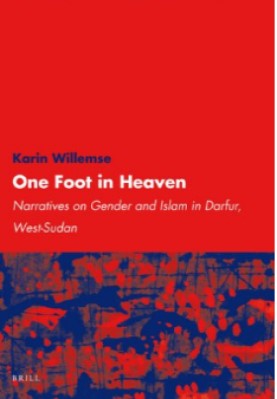One Foot in Heaven: Narratives on Gender and Islam in Darfur, West-Sudan

| One Foot In Heaven |
| Karin Willemse |
| 580 |
| |
| PDF Direct Download Link |
| Click for Hard Copy from Amazon |
ONE FOOT IN HEAVEN – Book Sample
PREFACE – ONE FOOT IN HEAVEN
The research on which this book is based was finished before 9/11 and before the Darfur War reached the level of violence it has suffered since 2002. Although every day brings bad tidings and horrible news, and although it will give no solace to the families who have fallen victim to the massacres and other violent attacks, I know that the women who figure in this book are still alive.
One of the reasons is that Kebkabiya, the town where I lived in 1990–1995 for about one and a half years altogether, is a garrison town. Even though Misteriya, the Janjawiid control center and stronghold of one of its warlords, Musa Hilal, is located in Kebkabiya district; and even when many of the attacks on villages took place in precisely this area, people living inside the town have so far been relatively safe.
To this function as a garrison town Kebkabiya allegedly owes its name. Gustav Nachtigal, the German traveler who visited Darfur in 1874, credited the founding of the town to ‘King Bokkor’ who ruled from approximately 1700 to 1720. He fought King, or Sultan, Arus from the neighbouring Wadai Sultanate in a battle near the place that was to become Kebkabiya, as Nachtigal states: “He was victorious in this battle, in which the Wadai warriors threw their shields away (Qabqabiya means ‘they threw their shields away’)”.1
Alternatively, this founding myth is ascribed to the son of this Sultan Bokkor (or Bukr), Sultan Tayrab (ruling 1752–1785). He brought the Sultanic court from Turra in the mountains of Jebel Marra to Shoba, some five kilometers from the Wadi where his garrison camped at present-day Kebkabiya: in this version Tayrab’s soldiers ‘lay down their shields’ after a battle was called off. Whatever version is correct, Kebkabiya has retained its importance as a protected town to this day.
Also its importance as a trading post dates back centuries as it was located on several of the trading routes from West-Africa to the Maghreb, Mecca, and on one of the most famous caravan routes, the darb al-arba”iin or forty-days road, up to Cairo.2 Al-Tunisi, who traveled in 1799 with the caravan of his father from Cairo to Darfur, described Kebkabiya in 1803: “The environs of which reminded me of the country places in Egypt; but the town is better built, richer, and more lively. Many foreigners are seen there.
The natives are, for the most part, wealthy merchants, having a great number of slaves, with which they trade”.3 In this town, about two hundred years later, I conducted the anthropological research that forms the basis for this book. It is about a society that has always been in the process of change and transformation, but whose survival has become threatened by the recent events in this region. It is not my place to foretell if the lifestyle and culture that I represent in the following pages have become extinct in the process.
I do, however, want to express the hope that Kebkabiya may live up to its name: that the people of Darfur, from whatever background, and in particular the leaders who are waging the current war, will find the courage to make peace and the wisdom to keep it: and will have a government that will sustain it.
Originally this book was written as a Ph.D. Thesis with the same title. My goal was to have the empirical research process guide the theoretical insights needed to understand local dynamics. The current publication has been updated.
Moreover, I have added introductions to each of the three parts in which the book is divided. The introductions of the parts contextualise the concepts I used while looking for meanings and alternative understandings of local events and narratives. In addition, Chapter 8 contains an epilogue in which I reflect on the war in Darfur since 2003.
I dedicate this book to the women of Darfur, for it is women who are most important in the processes of reconciliation and survival. I think in particular of those incredible women in Kebkabiya who hosted me and made me feel at home and whom I have come to admire for their beauty and strength, articulateness and determination, hospitality and sense of humor. They trusted me to take their narratives across borders so their views would be known and they have encouraged and inspired me to write this book.
This book is based on oral sources. Turning narratives into texts presents huge problems with regard to the spelling of names and phrases in local language. Moreover, the pronunciation of the colloquial Sudanese Arabic differs in some instances considerably from the standard Arabic.
To read more about the One Foot In Heaven book Click the download button below to get it for free
Report broken link
Support this Website
for websites